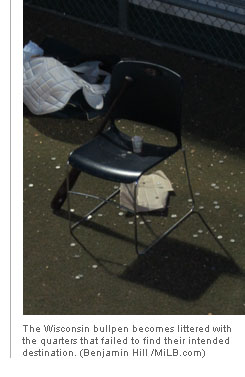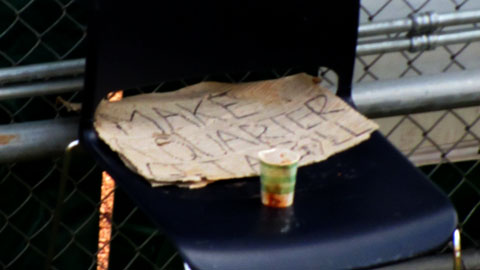Rattlers relievers dish on quarter game
"Make Quarter. Get A Ball."
These five words, indelicately phrased as they may be, have been a veritable goldmine for the Wisconsin Timber Rattlers bullpen this season. During each home game at Fox Cities Stadium, a cardboard sign with these five words scrawled upon it is placed atop a blue plastic chair in the bullpen, and just in front of the sign is a small Dixie cup. The bullpen is located in right field, and if any fan standing on the above concourse is able to throw a quarter into the cup then he or she will be rewarded with his or her very own official Midwest League baseball (or, in some cases, even a game-used bat). But if the throw misses? Then that quarter then belongs to the bullpen.
It's simple, really: "Make Quarter. Get A Ball."
Seeking more information on this nightly ballpark moneymaker, I interviewed three members of the Timber Rattlers bullpen prior to Saturday's game against Cedar Rapids: Jonathan Armold, Mike Strong (or Thee Mike Strong, as he confidently referred to himself as) and Taylor Wall. This triumvirate of relievers dished on the specifics of their moneymaking enterprise, as well as the overall supremacy of life in the bullpen.
MiLB.com: So, every night you guys are out there inviting fans to throw a quarter into a cup. What happens, exactly, if a quarter makes it into the cup?
Jonathan Armold: There are two designated cups, usually. One cup designated for a ball, that's an easier cup to make it in. But if the cup you make it in is further back, then you get a game-used bat.
MiLB.com: What sort of dimensions are we talking about here? How far do you have to throw the quarter?
Thee Mike Strong: I'd say that it's about 15 feet down and about 20 feet out, that's the one for the bat. And the one for the baseball is, again, 20 feet down and about 12 feet out.
Taylor Wall: Give or take.
MiLB.com: On average, how many people try their luck and try to throw quarters into these cups?
Armold: Our best, most lucrative, days are Kids Days [promotions] where all the kids come down to the bullpen.
Strong: We like Kids Day because they bring all of their meal money down there. They exchange it for quarters and we usually make a pretty good profit off of that.
MiLB.com: As professional athletes and role models, is there a sense of guilt when it comes to taking money from the youngest members of our society?
Armold: No, it's a game for all to enjoy. We'll give balls to kids randomly too if they spend enough money and hang out enough and are nice enough and don't beg for balls.
Strong: If they're in the $10 or $15 range, we'll usually give them a baseball or something.
MiLB.com: And how many people win each night, on average?
Wall: Last night we gave away a bat, and one night we gave away four bats.
Strong: That was a bad night for us.
Marmold: We'll give away a couple of balls per night, at least.
MiLB.com: Have you learned to identify contestants who are particularly good at this game?
Marmold: It's usually people who are well versed in beer pong.
Strong: Yeah, when they're doing this one [puts thumb, index and middle finger together and mimics overhand throwing motion] you know that they're probably pretty good.
MiLB.com: You know, I really should have asked this first. How did this game start happening in the first place?
Strong: Since this is my second year [with the Timber Rattlers], it's been passed down from generation to generation. Last year we did it and were pretty successful, so I wanted to share [gestures to Wall and Armold] with my fellow bullpen [members]. Last year we used a bubble gum bucket, but realized that was way too easy so we had to make it into a Dixie Cup.

MiLB.com: Are there any other games that you guys play out in the bullpen?
Strong: Sometimes we do cheese curds for baseballs.
MiLB.com: Cheese curls for baseballs? How does that work?
Strong: If someone brings a bag of cheese curds over then we'll give them a baseball, because cheese curds are delicious.
Armold: Wisconsin!
(As Armold, Strong and Wall laugh among themselves, an unidentified player walks by after exiting the batting cage and disdainfully mutters "Pitchers.")
MiLB.com: Do you get that kind of reaction a lot?
Strong: Of course.
Wall: Absolutely.
Armold: It's just jealousy. Hitters are just jealous that they don't get [cheese curds].
Wall: And the starters, they're jealous too.
MiLB.com: So would you guys consider yourselves to be the most privileged members of the team?
Strong: Oh, yeah. We're one of a kind.
Armold: 100 percent.
MiLB.com: So, back to the game with the quarters. What do you end up doing with the money you earn?
Armold: We lump it up into a bullpen fund and one of us will hold onto it, and we'll take all the quarters to the bank.
Strong: Or we hold onto it until we get to Burlington [Iowa, home of the Bees], because there's a casino there. So then we don't have to use our own money, we use that.
MiLB.com: You're using house money, then. Or, I guess more accurately, kids' money.
Strong: Exactly! It's all for the kids.
Armold (laughing): We probably shouldn't put that in an article.
Benjamin Hill is a reporter for MLB.com and writes Ben's Biz Blog. Follow Ben on Twitter @bensbiz.

